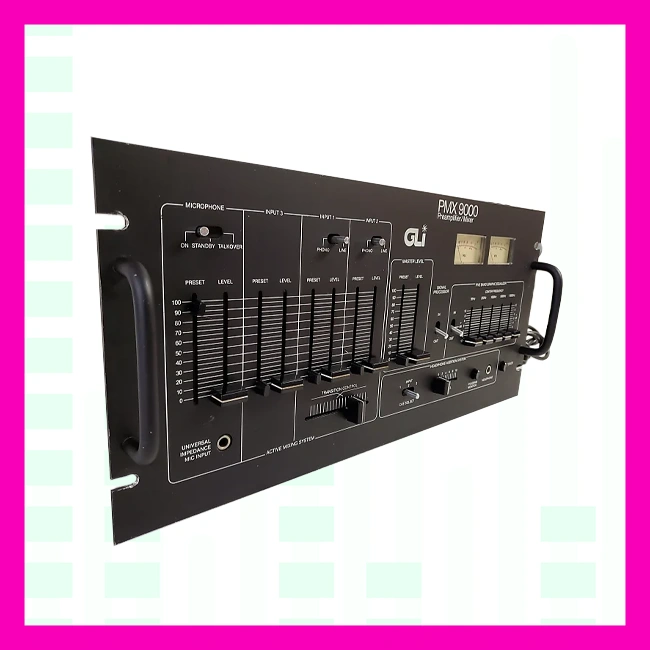
Nostalgia is a powerful feeling. There is no doubt that old school turntables reflect the advances in DJ technique; or in other words, some of them could be the mirror of DJ culture. For the past decades, turntables have been the heart and soul of the DJing world.
And all started with a couple of turntables and a mixer in the early ’70s.
5 old school DJ mixers that changed electronic music
Over time, we’ve seen certain pieces of equipment that changed the course of DJ history. These products defined decades of musical innovation and ultimately helped to shape the DJs into what they are today:
- Technics 1200 DJ Turntable
- GLI PMX 9000 Crossfader DJ Mixer
- CDJ-1000 Vinyl-Emulation CD Player
- Stanton’s Final Scratch With DVS
- VCI-100 Controller
Technics 1200 DJ Turntable

First introduced in 1970, the original Technics 1200 sparked the hip-hop revolution that eventually lead to DJing. Technics is widely recognized as one of the most influential brands in DJ history. The 1200 turntable was the first DJ mixer to be truly designed with DJs in mind, with design options from S-shaped tonearms to powerful direct-drive motors and nudge-friendly platters.
What makes this product so important in the history of DJing is the high-power direct-drive motor. Unlike consumer turntables, which connected the motor to the platter with a rubber pulley belt, the 1200’s drive was connected directly to the platter and spindle. This allowed the plate to stop, connect and nudge easily, unlike belt-driven turntables, which would break from such wear.
Subscribe to our newsletter 🎧
This turntable solved many problems DJs faced in the past, such as using belts quickly and easily skipping tonearms. The combination of a direct-drive motor and tone control was perfect for scratching and beatmatching, meeting all the requirements of DJ equipment for the first time.
GLI PMX 9000 Crossfader DJ Mixer

The GLI PMX 9000, first produced in 1979, was another important device in the development of DJ culture. It was one of the first mass-produced DJ mixers, using DJ-friendly faders instead of small knobs.
What made the PMX 9000 so innovative was the introduction of the crossfader, which was an integral part of the development of juggling beats and scratching.
The PMX 9000 sparked the rapid development of DJ mixers over the next few years. It led to the popularization of many integrated technologies, such as 3-band EQs and per-channel cue. The most important thing that standardized this mixer was the crossfader, which is an integral part of many different DJ techniques.
CDJ-1000 Vinyl-Emulation CD Player

In the late 90s and early 2000s, the world was making the transition from analog to digital, and CDs were slowly replacing cassette tapes and vinyl records.
However, DJs still used vinyl almost exclusively, because at the time CD players were primitive and counterintuitive, with no scratch control, making them useless for DJs, especially compared to turntables.
The CDJ-1000 (later known as mk1), changed all that and more. It was released using the revolutionary jog wheel technology that provided a turntable-like way to manipulate a digital track.
The wheel was essentially a giant 7-inch encoder. When the wheel was pushed, it slowed and increased the speed of the belt, and when pushed and manipulated, it scraped the belt. This technology sealed the deal for many digital DJs, enabling the transition from vinyl to digital in clubs around the world.
In addition to this revolutionary technology, the CDJ 1000 also offered other interesting features. It had a revolutionary “cue point” system that allowed the DJ to set markers on each track that could be accessed at the touch of a button. Three of these cues, called hot cues, could be launched perfectly, while the rest, called “memory points,” would stop the track and require time to load.
Stanton’s Final Scratch With DVS

Stanton’s Final Scratch was the first DJ-oriented software, which helped to transform the DJ industry. Even with the advancement of CDJ, many DJs still insisted on using vinyl for their setups.
Final Scratch essentially served as the first method of playing music on the computer for DJs.
It used a technology called DVS, or “Digital Vinyl System,” to control the playback of computer-based tracks using turntables. Final Scratch read special records called “time codes” that were pressed with a modulated signal.
This signal was sent to the PC through an audio interface and analyzed by the software, which played tracks that basically “followed” the record players. When the DJ stopped recording, the digital track stopped. When the DJ scratched the record, the software scratched the track. This technology was adopted by almost all old-school DJs, bringing back superior control of vinyl.
The introduction of Final Scratch eventually brought DJ functionality to personal computers, offering better storage and library management options than the USB sticks and relatively primitive navigation systems of early CDJs.
VCI-100 Controller

The VCI-100 controller was almost solely responsible for bringing digital DJing into the mainstream. It was a dedicated DJ controller that provided CDJ-style control over Traktor software.
It offered CDJ-style jog wheels that could be used for scratching, a full 2-channel mixer, effects controls and hot cues, all in one unit.
Some controllers prior to the VCI-100, such as the Hercules DJConsole, were released earlier, but they were extremely limited, with jog dials that couldn’t scratch, no effects controls and confusing layouts. The VCI-100 tried to provide a familiar design, using a “two-deck and mixer” design.
This controller, along with its even more successful mk2 (remember the mk1?), was used by almost every digital DJ of the time. Top DJs such as Ean Golden, DJ Shakey and Moldover used this controller, either alone or combined with other devices.
The VCI-100 was the first controller that was a comparable option to a mixer and CDJ setup. It popularized the use of DJ software and provided an affordable, feature-rich device for beginner DJs and controllers.
